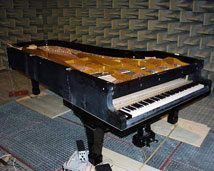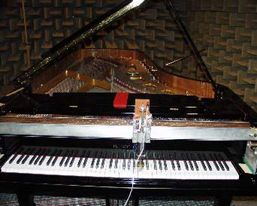
Data Acquisition Technology Helps Further Improve Sound Quality of Pianos

Czech piano manufacturer Petrof has developed an extensive acoustic measurement system used to improve the sound quality of its pianos. The system collects huge amounts of tonal data, performs sophisticated analyses simultaneously with the data acquisition, and generates spectral and wave diagrams and other graphics that help to judge sound quality. The key to using the PC platform was an analog-to-digital (A/D) converter with an onboard microprocessor. Called a data acquisition processor (DAP), the A/D converter-microprocessor performs FFTs simultaneously with the data acquisition, then transfers the results to a data analysis and visualization program for the creation of the wave diagrams. "The DAP made it possible to build this system around a PC by letting us do the data acquisition and conversion independently of the computer's CPU and Windows operating system," says Jan Skala of Petrof's Research Department.
With 1,000 employees and five plants, Petrof is the largest piano manufacturer in Europe. The more than 135-year old company, located in Hradec, Kralove in the Czech Republic, sells its pianos in more than 80 countries around the world. More than half a million Petrof pianos, both upright and grand, have been sold under the trademarks of Petrof, Weinbach, Scholze, Rösler, and Fibich. Grand pianos are available in five sizes and four surface finishes: gloss black, gloss white, walnut, and polished mahogany. Upright pianos are available in four basic heights and a wide range of hand-finished surfaces. Petrof also builds custom upright pianos.
The Quest for Improved Sound Quality
“With a DAP, we can quickly convert a large amount of data into useful information. The other advantage is cost. With this device, we created a relatively inexpensive testing system, yet one that plays an important role in Petrof's quest for ways to further improve sound quality.”
Jan Skala, Petrof ltd [Europe's largest piano manufacturer]
Commitment to research
One of Petrof's corporate goals is to continuously improve the quality of its pianos. Designers pay a great deal of attention to finding new ways to obtain the highest-quality sound characteristics. They are supported by an acoustic research department and a development department charged with developing new technology. "For decades the grand and upright pianos have been designed through the cooperation of manufacturers and musicians," says Skala. "The empirical knowledge achieved by that cooperation is being complemented more and more by musical acoustics and physics. These disciplines enable us not only to describe the technical processes taking place inside and around musical instruments, but can also help to improve the sound of the instruments."
Five years ago, Petrof demonstrated its strong commitment to innovation by opening a state-of-the-art research center with its own high-capacity anechoic measuring chamber, the largest of its kind in the Czech Republic. Anechoic means "neither having nor producing echoes." Petrof's anechoic chamber is a large room built on springs to eliminate vibrations coming from vehicles passing by outside. The inside of the chamber is covered with conical shaped pieces of melted stone that prevent sound from echoing off the walls. This chamber is crucial to evaluating piano quality because it makes it possible to measure the pure sound coming from the instrument. It also permits comparisons between one instrument and another. "If we tried to take the measurements in a normal room, echoes would influence the readings. Since you wouldn't have the same echoes each time, it would not be possible to compare measurements," says Skala.

Engineers use the anechoic chamber to test not only the complete instrument but also individual parts such as hammers, strings, and soundboards. During a test, two specially designed "fingers" of magnetic coils play the piano, stepping up the keyboard one tone at a time. A microphone picks up the sound coming from the instrument, sends it through an amplifier, and then into a PC where a variety of different measurements are generated. One measurement is the maximum intensity of the tone, indicated by the decibel level. Another measurement is the decay rate for the tone. When a tone is played, it has an initial intensity level of 80 decibels for example. The decay rate is the amount of time that elapses between the maximum intensity and when it drops to below 30 decibels. The decay rate depends on the construction of the piano as well as on the notes themselves. Notes on the bass scale have decay rates of more than 10 seconds while those in the treble scale decay in less than one second. A third measurement involves producing wave diagrams for each tone.
Obtaining wave diagrams presented a challenge to the engineers who designed Petrof's measurement system. Spectral diagrams are 3D plots of time, frequency and magnitude. For input, they require fast Fourier transformations (FFT) of the incoming piano sounds. The sampling rate for this parameter is 50 kHz, so the amount of data coming in from microphones is quite large. A single tone is sampled for 10 seconds, and the tone is changing continuously during this time. The engineers wanted FFTs to be performed simultaneously with the data collection so the results could be transferred to the MATLAB data acquisition and visualization program from The MathWorks Inc., Natick, Massachusetts, for conversion into wave diagrams.
One of the options for the configuration of the test system was to equip a PC with a conventional A/D card and computational software that would perform the FFTs. This would have been an easy and inexpensive solution, but the fact that Windows is not a real-time operating system led Skala to anticipate performance problems. If the FFT functions were to run under Windows, the system would be vulnerable to a situation where Windows was occupied with other tasks, possibly interrupting the data flow. "To move this much data around in real time, computing power has to be available when it is needed, every millisecond or so. Operating systems like Windows use up many cycles on the PC platform, and when they take control of the CPU they hold onto it for a long time in machine control terms," Skala explains. "We needed a way to move data through the system without involving the Windows or the PC's CPU."
Another option was to use separate systems for each task: a dedicated data acquisition device for data collection and the PC for performing the FFTs. While performance would have been adequate with this approach, it had the drawback of being more expensive. Also, a two-part system would have complicated the testing process. Engineers would have to learn two user interfaces, and setting up two pieces of equipment would have added to test time.
Then Skala discovered a third alternative, a DAP board for the PC platform from Microstar Laboratories, Bellevue, Washington. The unique capability offered by DAPs is an onboard microprocessor that runs a multitasking, real-time operating system optimized for high-performance real-time data acquisition and control applications. The intelligence on the DAP board extends the power of the Windows user interface by executing all processor-intensive routines, including FFTs, in real time so that the software on the PC can handle more demanding applications than usual. There's never any danger of losing data regardless of how many computer cycles are dedicated to the foreground application or even if Windows crashes. The data acquisition processor continues to run the special routine that collects data from the acquisition devices totally independent of the central processor.
Programming and operating the DAP
The engineers programmed the DAP board using DASYLab, a PC program that allows data acquisition and control applications to be represented as a data flow diagram directly on the screen. Icons selected from a module bar are positioned and connected with the mouse to form a schematic flowchart of the different stages in the flow of data -- input, processing, and output -- with a module represented by and icon at each stage. Editing is easy as modules can be added, moved, and deleted at the click of a mouse. When DASYLab is run, the modules are downloaded as DAPL commands, the language of the DAP's onboard operating system. Engineers use DAPtools for MATLAB, from Microstar to communicate with the DAP from the MATLAB programming environment.
Configuring the acoustic measurement system with a DAP allowed Petrof to create a sophisticated testing system built on the PC platform. In addition, having the ability to compute FFTs as sound data is being collected allows engineers to quickly generate the wave diagrams that help them to judge sound quality.
"The advantage of the DAP is that it lets us handle a large amount of data on a PC, independently of PC operations. With a DAP, we can quickly convert a large amount of data into useful information," says Skala. "The other advantage is cost. With this device, we created a relatively inexpensive testing system, yet one that plays an important role in Petrof's quest for ways to further improve sound quality."
Browse other customer applications.
